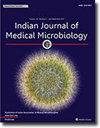Expanding geographical niche of emerging pathogen Fonsecaea nubica: First report of its isolation from India from a case of chromoblastomycosis
IF 1.4
4区 医学
Q4 IMMUNOLOGY
引用次数: 0
Abstract
A 19-year-old male from Odisha state was diagnosed with facial chromoblastomycosis caused by Fonsecaea nubica, initially misidentified as F. pedrosoi. Sequencing of Internal transcribed spacer region of rDNA confirmed F. nubica, marking its first detection in India. This highlights the need for further research and monitoring of epidemiology of chromoblastomycosis.
扩大新发病原菌的地理生态位:首次报道其从印度的一个嗜色菌病病例中分离出来。
一名来自奥里萨邦的19岁男性被诊断为面部嗜色菌病,最初被误认为是嗜色菌。rDNA内部转录间隔区测序证实了nubica,标志着其首次在印度被发现。这突出了进一步研究和监测成色菌病流行病学的必要性。
本文章由计算机程序翻译,如有差异,请以英文原文为准。
求助全文
约1分钟内获得全文
求助全文
来源期刊

Indian Journal of Medical Microbiology
IMMUNOLOGY-
CiteScore
2.20
自引率
0.00%
发文量
154
审稿时长
73 days
期刊介绍:
Manuscripts of high standard in the form of original research, multicentric studies, meta analysis, are accepted. Current reports can be submitted as brief communications. Case reports must include review of current literature, clinical details, outcome and follow up. Letters to the editor must be a comment on or pertain to a manuscript already published in the IJMM or in relation to preliminary communication of a larger study.
Review articles, Special Articles or Guest Editorials are accepted on invitation.
 求助内容:
求助内容: 应助结果提醒方式:
应助结果提醒方式:


